Wadgaon
| Author:Laxman Burdak, IFS (R) |
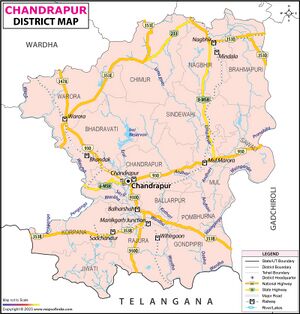
Wadgaon (वड़गाँव) is a village in Warora tahsil in Chandrapur district in Maharashtra.
Variants
- Waḍgaon (वड़गाँव)
Location
Wadagaon is a Village in Warora Taluka in Chandrapur District of Maharashtra State, India. It belongs to Vidarbha region . It belongs to Nagpur Division . It is located 64 KM towards North from District head quarters Chandrapur. Wadagaon is surrounded by Bhadrawati Taluka towards South , Hinganghat Taluka towards west , Samudrapur Taluka towards North , Maregaon Taluka towards South. This Place is in the border of the Chandrapur District and Yavatmal District. Yavatmal District Wani is South towards this place. [1]
Jat Gotras Namesake
- Bad (बड़) (Jat clan) → Wadgaon (वड़गाँव) is a village in Warora tahsil in Chandrapur district in Maharashtra.
- Wadiyar (वड़ीयार) (Jat clan) → Wadgaon (वड़गाँव) is a village in Warora tahsil in Chandrapur district in Maharashtra.
Wadgaon Plates of Pravarasena II
[p.53]: These plates were handed over to Dr. S. S. Patwardhan, Curator of the Central Museum, Nagpur, by one Bhagwan Shiva Ganar of Yenur, a village in the Hinganghat tahsil of the Wardha District, in Vidarbha. They were in the possession of his grandfather at Wadgaon (वड़गाँव) in the Warora tahsil of the Chanda District. They were published by me with facsimiles in the Epigraphia Indica, Vol. XXVII, pp. 74 f. They are edited here from the same facsimiles. The plates are now deposited in the Prince of Wales Museum, Bombay.
The copper-plates are four in number, of which the first and the last are inscribed on the inner side only, and the other two on both the sides. .....There are forty-two lines of writing in all, which are evenly distributed on the six inscribed faces of the four plates. The writing is in a good state of preservation throughout. In a few cases the engraver has corrected his mistakes of omission and commission; see amsa-bhāra-, line 4, saty-ārjjava, line 9 etc. ; but there are many more which are left uncorrected. In the right-hand lower corner of the first side of the second plate, he has incised the syllables Mārade(dā)se, 'which were inadvertently omitted in line 421. In line 21 several letters were beaten in and in their place the expression vishuva-vāchanaka- was incised. This correction or tampering, whatever it might be, was apparently done in the Vakataka age; for the substituted aksharas are of the same type as the rest of the record.
The characters are of the box-headed variety of the southern alphabet resembling those of the other inscriptions of Pravarasena II. The noteworthy peculiarities are the cursive form of the medial ū in sūnoh, line 4; the bipartite an in dauhitrasya, line 7 ; the medial ṛi, which is formed not by the usual curling curve, but by the addition of a curve turned downwards on the left of k in -adhikritā, line 23; and the rare medial ḷi in kḷipt-lopakḷiptah, line 31. The numerical symbols for 400 occur in line 20, and those for 2 and 3 on the second side of the second and the third plate respectively. The language is Sanskrit, and, except for two benedictive and imprecatory verses, the whole record is in prose. The orthography shows the usual reduplication of a consonant after r and before y ; see ārjjava-, line 9 and Bhāgiratthy-, Line 6.
The inscription is one of the Vakataha Maharaja Pravarasena II. It opens with drishtam. The genealogy of the king is given here exactly as in his other plates, his maternal grandfather being called Devagupta. The object of the inscription is to record the grant of 400 nivartanas of land by the royal measure, which Pravarasena II made to a Brahmana named Rudrārya, who was versed in two Vedas and belonged to the Vaji-Lohitya gotra2. He was a resident of the village Ekarjunaka (एकार्जुनक). The land donated to him was in the village Velusuka (वेलुसुक) which was situated in the Supratishtha ahara (सुप्रतिष्ठ आहार) or subdivision. The village lay to the east of Gridhragrama (गृध्रग्राम), to the south of Kadambasaraka (कदम्बसरक), to the west of Niligrama (निलीग्राम) and to the north of Kokilara (कोकिलार). The plates were issued from the royal camp on the bank of
1 For another instance of a correction inserted in a wrong place, see above, p. 39, n. 1.
2 A similar gotra, with Vāji prefixed to it, is Vāji-Kaushika mentioned in the Indore plates, line 15. In both these cases the donees may have belonged to the Vajasaneya shakha of the Yajurveda.
[p.54]: the river Hiranya on the tenth tithi of the bright fortnight of Jyeshtha in the twenty-fifth year1, evidently of the reign of Pravarasena II. The Senapati at the time was Bappadeva, He is mentioned also in the Siwani plates of Pravarasena II. The scribe was Māradāsa.
The donee Rudrārya is styled vishuva-vāchanaka (reciter at a vishuva) which suggests that the grant was made on the occasion of a vishuva or equinox. The vishuva immediately preceding the date of the grant wvas that of the Mesha-sankranti falling in Chaitra. The grant was evidently made to the Brahmana for reciting certain sacred texts on the occasion of the vishuva or Mesha-sankranti.
As for the localities mentioned in the present grant, the Supratishtha ahara (सुप्रतिष्ठ आहार) in which the village Velusuka (वेलुसुक) was situated is mentioned in two other grants, viz., the Poona plates of Prabhavatigupta and the Jamb plates of Pravarasena II. It seems to have comprised parts of the Hinganghat, Warora and Yeotmal tahsils of the Wardha District, Chanda District and Yeotmal District respectively. The village Velusuka in which the donated land was situated cannot now be traced, but it seems to have occupied the same position as modern Chinchmandal which lies just on the south of the elbow of the Wunna; for all the boundary villages mentioned in the present charter can be traced in the vicinity of it in the respective directions. Thus
Gridhragrama (गृध्रग्राम) is Gadeghat about 8 miles to the west, and Niligrama (निलीग्राम) is Niljai, about 5 miles to the east of Chinchmandal.
Kadambasaraka (कदम्बसरक) is Kosara, about 2 miles to the north.
Kokilara (कोकिलार) is modern Khairi which lies about 4 miles to the north-west. All the boundary villages can thus be satisfactorily identified in the vicinity of Chinchmandal. It is again noteworthy that Chinchmandal (चिंचमंडल) lies only about 5 miles to the south of Wadgaon where the plates were found. The river Hiranya is the modern Erai, which flows from north to south in the Warora tahsil and ultimately joins the Wardha River.
Ekarjunaka (एकार्जुनक) where the donee resided is probably Arjuni on the left bank of the Erai, about 16 miles north-east of Warora, the chief town of the Warora tahsil.
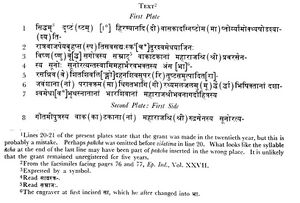
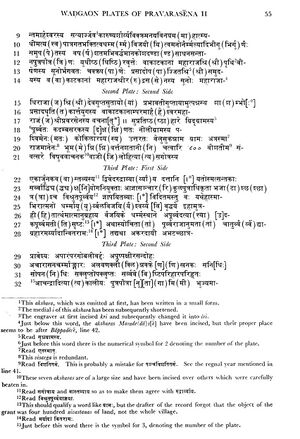
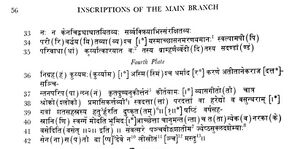
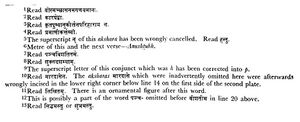
[p.56]: Success! Seen. From the camp on the River Hiranya (हिरण्य नदी)
By the order of the illustrious Pravarasena (II), the Maharaja of the Vakatakas and a devout worshipper of Maheshvara, who, by the grace of Shambhu, has established the Krita-yuga (Golden Age) (on the earth), who was born of Prabhavatigupta, the daughter of the Maharajadhiraja, the illustrious Devagupta, (and) who is the son of the illustrious Rudrasena (II), the Maharaja of the Vakatakas —
(There is) a village named Velusuka (वेलुसुक) in the āhāra of Supratishtha (सुप्रतिष्ठ आहार), which lies to the east of Gridhragrama (गृध्रग्राम), to the south of Kadambasaraka (कदम्बसरक), to the west of Niligrama (निलीग्राम) and to the north of Kokilara (कोकिलार). From this (village) four hundred nivartanas — (in figures) 400 — of land by the royal measure have been donated to Rudrārya of the Vaji-Lohitya gotra, who resides at Ekarjunaka (एकार्जुनक) and who has recited (the Vedic mantras) on the occasion of the Equinox (Vishua).
The (following) two verses sung by Vyasa should be regarded as authoritative on this point ; —
(Line 41). (This charter has been) written by Māradāsa, while Bappadeva (बापदेव) is the Senapati, on the tenth (lunar day) of the bright (fortnight) or Jyeshtha in the twenty-fifth (regnal) year. May there be happiness!
Wiki Editor Notes
- Bappi (बप्पी) (Jat clan) → Bappadeva (बापदेव). Bappadeva (बापदेव) is the Senapati mentioned in Wadgaon Plates of Pravarasena II[2]
- Gada (गदा) (Jat clan) → Gadeghat (गदेघाट) = Gridhragrama (गृध्रग्राम) mentioned in Wadgaon Plates of Pravarasena II[3] Gadeghat (गदेघाट) is a village in Wani tahsil in Yavatmal district in Maharashtra. It has been mentioned as Gridhragrama (गृध्रग्राम) in Wadgaon Plates of Pravarasena II[4]
- Kok (कोक) (Jat clan) → Kokilara (कोकिलार). Kokilara (कोकिलार) is mentioned in Wadgaon Plates of Pravarasena II. It has been identified with Khairi. [5] Khairi (खैरी) is a village in Ralegaon tahsil in Yavatmal district in Maharashtra.
- Kosar (कोसर) (Jat clan) → Kosara (कोसरा). Kosara (कोसरा) is a village in Maregaon tahsil in Yavatmal district in Maharashtra. It has been mentioned as Kadambasaraka (कदम्बसरक) in Wadgaon Plates of Pravarasena II[6]
- Neel (नील) (Jat clan) → Niljai (नीलजयी). Niljai (नीलजयी) is a village in Wani tahsil in Yavatmal district in Maharashtra. It has been mentioned as Niligrama (निलीग्राम) in Wadgaon Plates of Pravarasena II[7]
- Waroria (वारोड़िया) (Jat clan) → Warora (वरोरा). Warora (वरोरा) is a town and tahsil in Chandrapur district in Maharashtra.
- Gadeghat → tah: Wani Yavatmal
- Gadegaon → tah: Maregaon
- Niljai → tah: Wani Yavatmal
- Niljai → tah: Kelapur
- Kosara → tah: Zari-Jamani
- Arjuni → tah: Maregaon
- Chinchmandal → tah: Maregaon
History
External links
References
- ↑ https://www.onefivenine.com/india/villages/Chandrapur/Warora/Wadagaon#google_vignette
- ↑ Corpus Inscriptionum Indicarum Vol.5 (Inscriptions of The Vakatakas), Edited by Vasudev Vishnu Mirashi, 1963, Archaeological Survey of India, p.53-56
- ↑ Corpus Inscriptionum Indicarum Vol.5 (Inscriptions of The Vakatakas), Edited by Vasudev Vishnu Mirashi, 1963, Archaeological Survey of India, p.53-56
- ↑ Corpus Inscriptionum Indicarum Vol.5 (Inscriptions of The Vakatakas), Edited by Vasudev Vishnu Mirashi, 1963, Archaeological Survey of India, p.53-56
- ↑ Corpus Inscriptionum Indicarum Vol.5 (Inscriptions of The Vakatakas), Edited by Vasudev Vishnu Mirashi, 1963, Archaeological Survey of India, p.53-56
- ↑ Corpus Inscriptionum Indicarum Vol.5 (Inscriptions of The Vakatakas), Edited by Vasudev Vishnu Mirashi, 1963, Archaeological Survey of India, p.53-56
- ↑ Corpus Inscriptionum Indicarum Vol.5 (Inscriptions of The Vakatakas), Edited by Vasudev Vishnu Mirashi, 1963, Archaeological Survey of India, p.53-56

